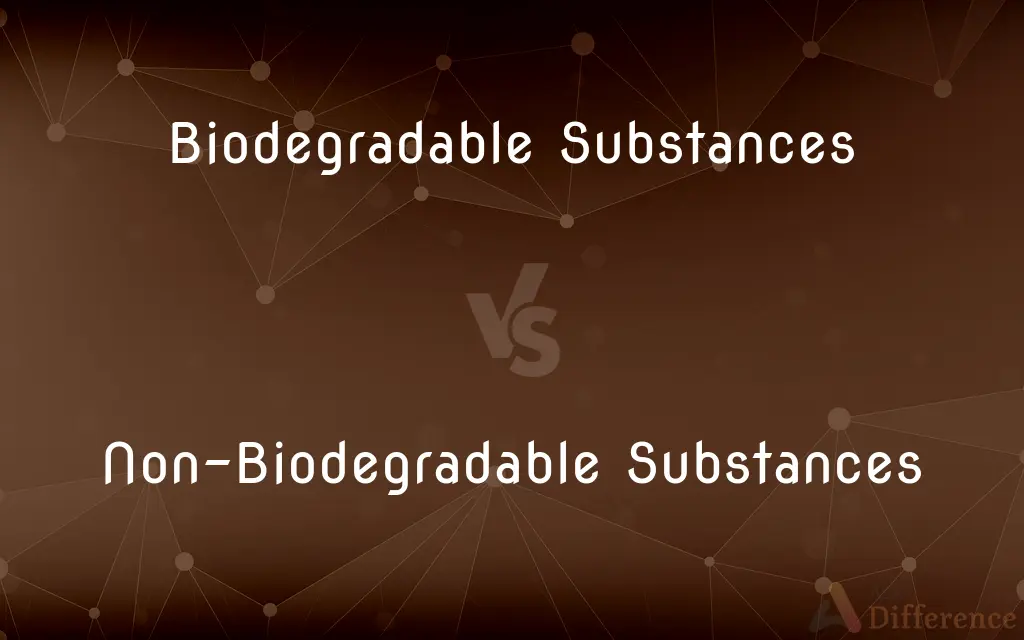Biodegradable Substances vs. Non-Biodegradable Substances — What's the Difference?
By Tayyaba Rehman — Published on December 14, 2023
Biodegradable substances break down naturally, while non-biodegradable substances persist in the environment without decomposing.

Difference Between Biodegradable Substances and Non-Biodegradable Substances
Table of Contents
ADVERTISEMENT
Key Differences
Biodegradable substances are materials that can be broken down naturally by microbial action, ultimately returning to the environment as harmless end products like water, carbon dioxide, and organic matter. In contrast, non-biodegradable substances do not decompose naturally or take an exceptionally long time to degrade, resulting in their persistence in the environment for extended periods.
Biodegradable substances typically come from organic origins, such as plants and animals. When these substances break down, they reintegrate into the earth without causing harm. Non-biodegradable substances, on the other hand, mainly originate from human-made products, especially those made of synthetic polymers, metals, and various inorganic compounds. Due to their unnatural composition, the environment often struggles to process and eliminate them.
One of the significant benefits of biodegradable substances is their sustainability and eco-friendliness. When products made from these materials are discarded, they decompose, leaving no lasting impact on the environment. Non-biodegradable substances present environmental challenges, accumulating in landfills, waterways, and other parts of the ecosystem. This accumulation poses long-term ecological risks, potentially leading to pollution and harm to both wildlife and humans.
It's essential to understand the differences between biodegradable and non-biodegradable substances when considering environmental health and conservation. While biodegradable substances align more with a circular economy, being used and then safely returned to the environment, non-biodegradable substances can disrupt this cycle, leading to linear and wasteful consumption patterns. This discrepancy highlights the need for sustainable practices and the potential dangers of relying too heavily on non-biodegradable products.
In conclusion, biodegradable substances play a crucial role in maintaining the planet's ecological balance due to their natural decomposition processes. Non-biodegradable substances, because of their resistance to natural breakdown, present environmental challenges that societies worldwide must address to ensure a healthy and sustainable future.
ADVERTISEMENT
Comparison Chart
Decomposition
Decompose naturally in the environment.
Persist in the environment without breaking down.
Time frame for decomposition
Decompose within a short period.
Can last for years to centuries.
Resultant byproducts
Produce natural byproducts like CO2 and water.
Can produce harmful residues and environmental pollutants.
Impact on environment
Environmentally friendly and reduce waste.
Lead to pollution and environmental harm.
Resistance to natural processes
Decomposed by microorganisms, sunlight, etc.
Resistant to most natural decomposition processes.
Compare with Definitions
Biodegradable Substances
Naturally recyclable materials.
Cotton fabrics are biodegradable substances that decompose with time.
Non-Biodegradable Substances
Matter leading to environmental accumulation.
Synthetic polymers are non-biodegradable substances clogging landfills.
Biodegradable Substances
Eco-friendly materials decomposing quickly.
Paper is among common biodegradable substances.
Non-Biodegradable Substances
Substances persisting in the environment.
Metals like aluminum are non-biodegradable substances.
Biodegradable Substances
Matter transformed into natural byproducts.
Wooden objects are biodegradable substances returning to the soil.
Non-Biodegradable Substances
Materials that don't decompose naturally.
Plastic bags are non-biodegradable substances.
Biodegradable Substances
Materials that naturally decompose.
Food waste is a type of biodegradable substance.
Non-Biodegradable Substances
Materials resistant to natural breakdown processes.
Glass bottles are typical non-biodegradable substances.
Biodegradable Substances
Substances broken down by natural agents.
Leaves from trees are biodegradable substances.
Non-Biodegradable Substances
Long-lasting substances in nature.
Styrofoam products are non-biodegradable substances that persist for centuries.
Common Curiosities
How long do biodegradable substances take to decompose?
The decomposition time for biodegradable substances varies but is generally much shorter than non-biodegradable materials.
Can non-biodegradable substances ever break down?
Some can break down over very long periods or under specific conditions, but generally, they persist for extended periods.
What defines non-biodegradable substances?
Non-biodegradable substances are materials that resist natural decomposition and persist in the environment.
How can we differentiate between biodegradable and non-biodegradable substances?
Observing decomposition over time and understanding the material's composition can help differentiate between the two.
Why are biodegradable substances considered environmentally friendly?
Biodegradable substances reduce waste, as they return to nature, minimizing environmental impact.
What are biodegradable substances?
Biodegradable substances are materials that naturally decompose through biological or environmental processes.
Do biodegradable substances produce any waste?
While they decompose more naturally, some biodegradable substances might produce methane or other byproducts.
Why are non-biodegradable substances an environmental concern?
Non-biodegradable substances accumulate in the environment, leading to pollution and potential harm to ecosystems.
Why don't non-biodegradable substances decompose?
Their molecular structure is resistant to the natural processes that break down materials.
What can be done to reduce non-biodegradable substance waste?
Reducing consumption, recycling, and finding alternatives are effective ways to manage non-biodegradable waste.
Can biodegradable substances cause pollution?
If not managed properly, even biodegradable substances can lead to pollution, such as methane emissions from landfills.
Are all plastics non-biodegradable substances?
While many plastics are non-biodegradable, there are biodegradable plastics designed to decompose faster.
Is biodegradability the only factor determining a product's environmental impact?
No, factors like resource usage, energy in production, and transportation also influence a product's environmental footprint.
Is paper a biodegradable substance?
Yes, paper is a biodegradable substance that breaks down over time.
Are all organic materials biodegradable substances?
While many organic materials are biodegradable, certain treatments or conditions might render them less degradable.
Share Your Discovery

Previous Comparison
Presale vs. General Sale
Next Comparison
Internal Audit vs. External AuditAuthor Spotlight
Written by
Tayyaba RehmanTayyaba Rehman is a distinguished writer, currently serving as a primary contributor to askdifference.com. As a researcher in semantics and etymology, Tayyaba's passion for the complexity of languages and their distinctions has found a perfect home on the platform. Tayyaba delves into the intricacies of language, distinguishing between commonly confused words and phrases, thereby providing clarity for readers worldwide.












































